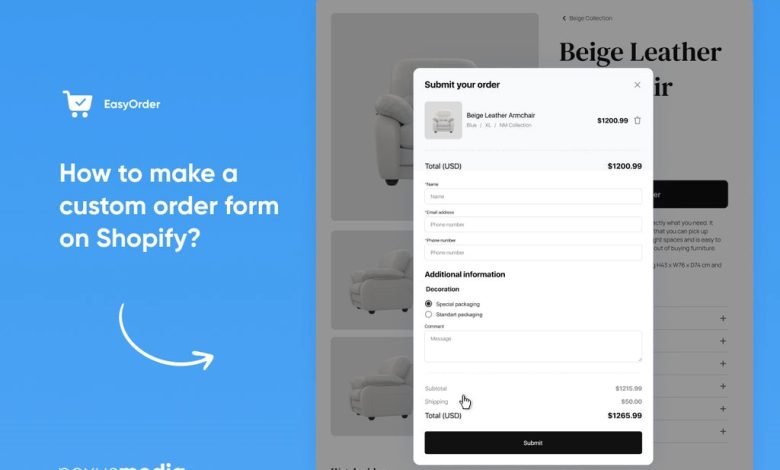How to Create a Custom Order Form on Shopify?

Enhancing E-commerce with Custom Order Forms on Shopify?
Shopify, as a global e-commerce player, offers businesses the popular feature of creating a Shopify custom order form. These forms simplify checkout, allow merchants to collect customer details, etc. In this guide, we’ll explore the benefits of these forms, provide a step-by-step guide on creating a custom order from Shopify, and offer tips to ensure their effectiveness.
Understanding Shopify’s Custom Order Form:
Custom order forms on Shopify are tailored web forms that enable merchants to collect specific details about customer orders. These forms are pivotal in enhancing the customer experience significantly when facilitating cash-on-delivery (COD) options or managing pre-orders.
Why Custom Order Forms Matter:
- Boosted Conversions: Tailored checkout processes can spike conversion rates by up to 35%.
- Decreased Cart Abandonment: Simplified checkout processes can combat the 69.8% cart abandonment rate.
- Enhanced Customer Loyalty: A seamless shopping experience can lead to repeat business, with 93% of customers returning to brands offering superior service.
Creating Your Custom Order Form on Shopify:
- Selecting the Right App: The Shopify app store offers numerous apps. We suggest the EasyOrder ‑ Order Form for COD app by NexusMedia.
- Installation and Onboarding: Familiarize yourself with its features and functionalities.
- Designing the Form: Use the app’s intuitive dashboard to design your form, adding fields and adjusting settings.
- Field Customization: Customize fields like name, email, address, and more to suit your needs.
- Branding the Form: Ensure the form’s design aligns with your brand’s aesthetics.
- Embedding the Form: Integrate the form into your Shopify store, choosing its placement and saving settings.
- Testing: Before going live, test the form for functionality and user experience.
Essential Fields for Your Custom Order Form:
- Customer details like name, email, and phone number
- Addresses for shipping and billing
- Specific order details like size, color, or customization
- Payment methods and special instructions
Top Tips for an Effective Custom Order Form:
- Simplicity is Key: A concise form can boost conversion rates by up to 120%.
- Transparent Language: Avoid jargon and use straightforward language.
- Thorough Testing: Ensure the form works seamlessly across devices and browsers.
- Continuous Optimization: Regularly review and refine the form based on performance metrics.
Conclusion
Custom order form on Shopify can revolutionize your e-commerce experience, streamlining order processes and enhancing customer satisfaction. Stay on edge, choose proper apps, and happy selling!
FAQ
What are the primary benefits of using custom order forms on Shopify?
Custom order forms on Shopify offer several advantages. They simplify the checkout process, allowing merchants to gather specific customer details. This enhances the customer experience, especially when facilitating cash-on-delivery (COD) options or managing pre-orders. Additionally, these forms can lead to increased conversion rates and reduced cart abandonment.
How can custom order forms impact the conversion rates and cart abandonment in an e-commerce platform like Shopify?
Tailored checkout processes, such as those provided by custom order forms, can boost conversion rates by up to 35%. On the other hand, a simplified checkout experience can combat cart abandonment, which stands at a rate of 69.8%. With simpler and more friendly check-out, customers are more likely to complete their purchases.
What are some essential fields to include in a Shopify custom order form to enhance the customer experience?
Essential fields in a Shopify custom order form include customer details like name, email, and phone number; addresses for shipping and billing; specific order details such as size, color, or any customization requests; and payment methods. Including these fields ensures merchants gather all necessary information while offering customers a seamless ordering process.




